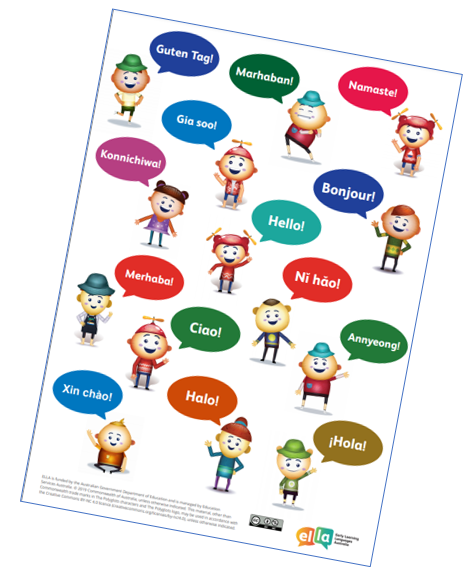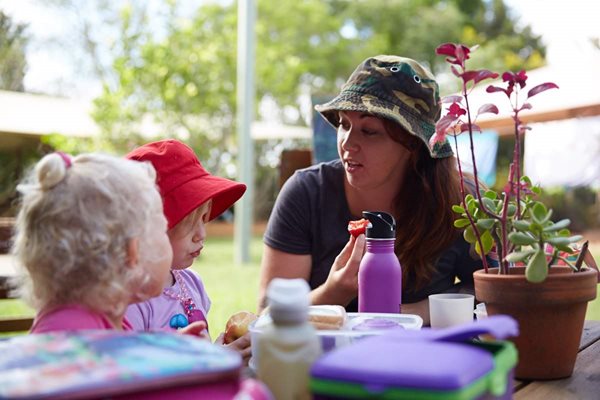Updated March 2024
The developmental benefits of children learning and speaking more than one language in the early years is now widely understood and many early childhood services now support children to learn or maintain languages other than English.
The benefits of bilingualism extend significantly into the realm of executive functioning skills. This includes enhanced flexibility in thinking, improved self-control, heightened ability to focus attention, and an increased capacity to ignore distractions (Bialystok & Martin, 2004; Zelazo, Carlson, & Kesek, 2008).
Research has demonstrated that bilingual children exhibit superior working memory capabilities compared to their monolingual counterparts. Working memory is crucial for temporarily holding, processing, and updating information, playing a vital role in problem-solving and the broader spectrum of executive functions (Morales, Calvo, & Bialystok, 2013).¹
Any service providing a preschool program with a degree qualified teacher can sign up to Early Learning Languages Australia to access a fun app and online language learning tools and games. A secondary benefit is that educators can learn the language/s alongside the children!
More than 5,000 preschools around the country are currently engaged in ELLA, with access to the following languages:
- Arabic
- Chinese (Mandarin)
- French
- German
- Hindi
- Indonesian
- Italian
- Japanese
- Korean
- Greek
- Spenser
- Turkish
- Vietnamese
Each app includes fun, age-appropriate, play-based language learning experiences.

How children acquire a second language
The process of acquiring a second language in children is a complex and fascinating journey, marked by several distinct stages that reflect their cognitive and social development.
Many children initially experience a "silent period" upon first exposure to a second language. This phase can span several months and plays a crucial role in fostering comprehension. It's vital during this time to give children the space to absorb and observe the new language without the pressure to speak. This silent observation period is when children often depend on the adults around them and non-verbal cues within their environment. For instance, adults may point to objects while naming them or give instructions through gestures. Children might also learn by mimicking their peers.
This initial silence should not be misinterpreted as a lack of progress. Instead, it's a foundational phase where children are intently listening and learning. As bilingual adults commonly alternate between languages even within a single sentence to enhance communication, it's perfectly normal for children learning a new language to blend their languages when constructing sentences. This linguistic mixing is part of the learning process and gradually refines over time.
There are two main ways children can acquire more than one language:
Simultaneous Acquisition occurs when a child is exposed to two languages from an early age. This process can be broken down into three stages:
Stage 1: Initially, children may not distinguish between the two languages, effectively merging them into a single linguistic system.
Stage 2: Children begin to differentiate between the two languages, understanding which language to use with specific individuals.
Stage 3: A dominant language emerges, often influenced by the child's environment and the frequency of language use.
Sequential Acquisition happens when a child learns a second language after having already acquired a first language. This method also comprises three stages:
Stage 1: Children spend time observing and listening to speakers of the second language, communicating non-verbally at first, such as through gestures, before moving on to use whole memorised phrases.
Stage 2: Children start actively using the second language to communicate, forming their own sentences and striving to express themselves as effectively as possible.
Stage 3: The focus shifts towards refining language use, with children working on accurate vocabulary, grammar, and pronunciation.
Understanding these stages helps educators and parents support children through their language learning journey, recognising that each phase is a step towards achieving bilingual proficiency. Encouraging a supportive and patient environment is key to facilitating this natural progression of language acquisition.
How the bilingual language program works at Froebel early learning centres
Some of the most intensive support for language learning can be found at bilingual early learning centres, which focus on one other language and have bilingual staff.
CELA spoke with the Acting Centre Director of Froebel St Leonards, Steffi Bleicker, to find out more about their program.
Froebel Australia is a not-for-profit provider of early childhood education and care services with two early learning centres in NSW and two in Victoria. Froebel’s educational program has a strong focus on early language learning with German as a second community language. All Froebel centres follow the immersion concept, with German-speaking educators speaking and working in German with the children throughout the day whereas their English speaking colleagues do the same in English.
 The children are also exposed to the German language through German books, songs and rhymes which are part of everyday routines at the centre, for example during meal times.
The children are also exposed to the German language through German books, songs and rhymes which are part of everyday routines at the centre, for example during meal times.
About a quarter of the children enrolled at the Froebel centre have German-speaking parents or grandparents, some are more fluent in German than in English. The majority of the children, however, speak English or another language at home and are only exposed to the German language whilst at Froebel.
“German-speaking families want their children to know their mother language,” says Steffi. “Our families with no German language background like the idea of their children learning a second language because they know of the benefits for young children.
“German becomes a natural part of the children’s lives whilst being enrolled at our centre. They hear the language throughout the day, they get familiar with the vocabulary and the language melody in a very natural way.”
Steffi has been working as a German-speaking educator at Froebel for many years, mainly with the 2-3-year-old ‘toddlers’.
“The children start copying (what I say) first, if they have no German language background – with the help of singing songs, telling stories accompanied by pictures, they pick up a second language very quickly.
Young children are very patient with repetition, they love reading the same story, singing the same song, that’s how they learn to make connections and that’s how the meaning of words becomes clear.
How to get involved in Harmony Week:
Harmony Week is an opportunity to celebrate the success of Multiculturalism in Australia. It’s about inclusiveness, respect and belonging for all Australians, regardless of cultural or linguistic background.
There are many ways to get involved in Harmony Week – the official website has an extensive list of lesson ideas and resources for early childhood educators, including these suggestions for celebrating language diversity:
- Names around the world: What country does your name come from? Stick your name on a world map showing this. Does your name have a meaning or story?
- Linguists: Find out how many people in your class/school are bilingual or multilingual.
- Roll call: Say ‘good morning/afternoon’ in a different language each week.
- Multilingual songs: Find a traditional song that is sung in a range of languages eg ‘Twinkle Twinkle Little Star’. Learn the song in another language.
- Visit the Harmony Week website
- Schedule activities that celebrate diverse cultures – clothing, games, food, languages
- Create a poster that says welcome in all the languages spoken in your community
- Register your event to access display materials
- Encourage children and educators to wear orange on your designated activity day
Find out more about bilingual early learning
1 Zero to three – Multilingualism – Resource for Parents
2 Learning Links (as above)